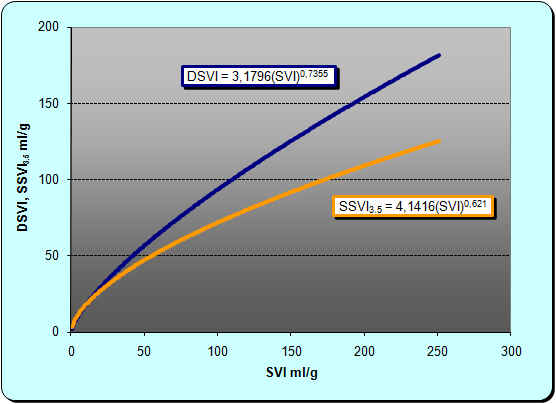|
Correct! |
||
|
|
|
|
SLUDGE VOLUME INDEX (SVI)
The sludge volume index (SVI), introduced by Mohlman in 1934, has become the standard measure of the physical characteristics of activated sludge solids. It is defined as "the volume in ml occupied by 1 g activated sludge after settling the aerated liquor for 30 min" (Dick and Vesilind, 1969).
Analytics
Measurement of activated sludge settling properties is not standardized internationally and many countries use the US Standard methods. (Standard Methods for the Examination of Water and Wastewater, APHA el al., 2005).
2710C the method for settled sludge volume;
2710D the determination of sludge volume index;
2710E the determination of zone settling rate;
2710I determines settled sludge volume using a 2-L graduated cylindrical vessel to allow suspension volume to be determined in relation to the results in 2710C.
|
Correct! |
||
|
|
|
|
|
Wrong! |
||
|
|
|
|
|
http://water.me.vccs.edu/courses/ENV149/imageLK8.jpg |
http://web.deu.edu.tr/atiksu/ana55/siskin.gif |
|
The size and the shape of vessels used for activated sludge volume measurement have a decisive effect on applicability and reproducibility of the data.
Conical vessels should be avoided!
Sludge Volume Index modifications
A variety of settling indexes is used in the worldwide practice.
The diluted SVI (DSVI) analysis
(Jenkins, et al, 1993; Koopman and Cadee, 1983)
|
This analysis is conducted by first diluting the sludge sample with process effluent until the settled volume after 30 minutes (SV30) is 250 ml/l or less. The SVI analysis is thus typically conducted on the diluted sample. |
The stirred specific volume index at 3.5 g/L (SSVI3.5) analysis
(Jenkins, et al., 1993; White, 1975; White, 1976)
|
This analysis is conducted at an MLSS concentration of 3.5 g/l, and slow stirring is used to minimize wall effects on the settled sludge volume. |
The stirred specific volume index at the aeration basin MLSS analysis
(Wahlberg and Keinath 1988)
|
This analysis is conducted at the aeration basin MLSS and slow stirring is used to minimize wall effects on the settled sludge volume. |
Both the DSVI and SSVI3.5 analyses were developed to eliminate the recognized effect of MLSS concentration on the measured result as obtained with the conventional SVI analysis (Dick and Vesilind, 1969). Both provide a more accurate characterization of settling characteristics than the SVI test, though SSVI3.5 has shown superior predictive capability.
CORRELATIONS
 |
Though correlation of DSVI and SSVI3.5 to SVI can be found, the spread along the regression lines is high. Thus it is meaningless to measure the conventional SVI, convert the values to DSVI or SSVI3.5 and use the converted values for process calculations (the solids flux curve, sludge blanket etc.). |
 |
Correlation between SSVI3.5 and DSVI is reasonably good and can be used for process calculations. |
Relation of the recycled sludge concentration to SVI
 |
Mines R.O., Vilagos J.L.: AWT & Conventional Mixed Liquor Settling Velocities. ASCE Conf. Proc., 48-48, 2000. |
|
|
|
|
|---|